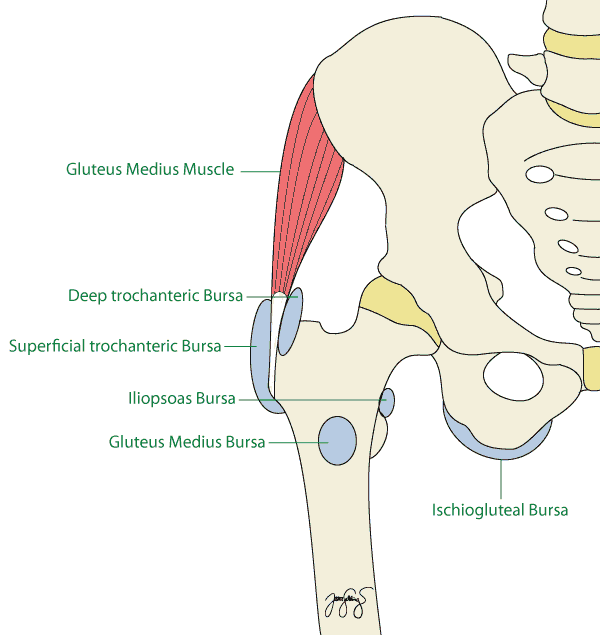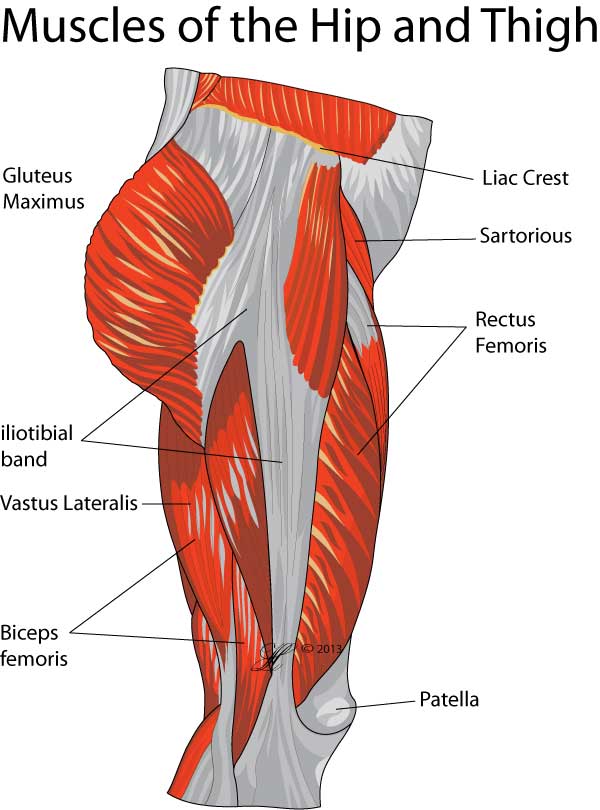A bursa is a fluid-filled sac that functions as a gliding surface to reduce friction between tissues of the body. Bursae are found near joints, especially where tendons attach themselves to the bone. Healthy bursae create a smooth, almost frictionless gliding surface making normal movement painless.
Bursitis is a condition where the bursa becomes inflamed. This may cause the bursa to become painful. It may also swell up leading to an obvious lump. This is less common in the hip due to the bursae being covered by overlying muscles.
There are a number of bursae around the hip joint.
These include:
- Trochanteric bursae (superficial and deep – closer to skin and further away from skin)
- Iliopsoas bursae
- Gluteus Medius bursae
- Ischiogluteal bursae
The trochanteric bursa is located on the side of your hip, and is the bursa that is most commonly inflamed around the hip.

Symptoms
Hip bursitis causes a dull, burning pain around the hip. Often, it is painful to lie on that side, making sleep difficult. The exact site of pain depends on the specific bursae affected.
Trochanteric bursitis – pain is felt in the hip, particularly over the bony prominence of the hip known as the trochanter which is the outer side of the hip. This is the most commonly affected bursae of the hip. It may be particularly sore to sleep on the side of the affected hip in trochanteric bursitis.
Iliopsoas bursitis – pain is felt in the groin area. Pain may be felt on walking, particularly when the affected hip is extended leading to a shortening of the normal stride length to reduce the pain. Sometimes a mass may be felt resembling a hernia. This condition is not as common as trochanteric bursitis.
Causes
Hip bursitis can affect anyone, but it is more commonly found in women and people in their middle ages and over.
The following risk factors have been associated with the development of hip bursitis.
- Repetitive trauma (overuse) injury. Any action that repetitively aggravates the hip bursa can lead to bursitis. Examples of actions that can cause repetitive trauma include: running, walking up stairs, riding a bike, or prolonged standing.
- Sudden trauma. A fall or a knock to the hip that directly affects the bursae can lead to bursitis. This is a less common cause of hip bursitis than repetitive trauma but can happen.
- Problems affecting normal walking. If your walking is affected by a condition that is pre-exisiting, one bursae may be subject to uneven force leading to inflammation of the bursae and subsequently bursitis. Conditions that can cause this include:
- Spine conditions: such as scoliosis and osteoarthritis
- Leg-length discrepancy: One leg can be shorter than the other for a number of reasons leading to one hip being subject to more stress than the other
- Knee osteoarthritis or ankle sprain. Both these conditions may lead to one leg being favoured which can then stress the bursa
- Rheumatoid arthritis. This is a form of arthritis that can make the bursa more prone to becoming inflamed.
- Previous surgery. Surgery to the hip, especially surgery involving the use of an implant can result in aggravation of the bursae.
- Bone spurs : Osteoarthritis is the most common cause of bone spurs. Once present, bone spurs may aggravate the bursae during normal walking or other activities.
Risk Factors
Hip Bursitis is more common if you are female and above 40 years of age.

Investigations
Once your doctor has taken a history of you hip pain, they will carry out an examination of the hip in order to find out where the pain is coming from.
The examination will involve palpating the hip (palpation is a method of feeling with the hands during a physical examination), testing the movement of the hip and observing if walking is affected.
In trochanteric bursitis, when the hip is palpated (examined using your hands) there will often be pain over the area of the greater trochanter (which is outer point of the hip). This pain should feel similar to the pain which caused you to seek medical attention.
Your doctor may also move the hip, rotating it in and out to see if this brings on the pain you have been experiencing.
Once the examination is complete, your doctor may also want to perform some additional investigations to rule out other possible causes of the hip pain. These may include:
- Blood tests
- X-rays
- Ultrasound
- MRI scans of the hip.
Occasionally, diagnostic injection of local anaesthetic into the trochanteric bursa may be helpful to confirm the presence of bursitis, but this is not always performed. It is useful in ruling out the presence of referred pain that may be coming from the back.
Complications
Trochanteric Hip Bursitis can worsen to involve tearing of the hip muscles and tendons. This can lead to constant pain, weakness and a limp when walking.
Treatment
Nonsurgical Treatment
The initial treatment for hip bursitis does not usually involve surgery. The first line of treatment for hip bursitis includes the following:
- Avoid activities which aggravate symptoms
- Avoid direct pressure on the bursa.
- Nonsteroidal anti-inflammatory drugs (NSAIDs) which may be prescribed by your doctor, for a period of up to four weeks. It is always important to check whether anti-inflammatory drugs are appropriate for you as there are other medical conditions which make their use less appropriate.
- Reduce weight bearing (eg, temporary crutches, a walking stick and weight loss for recurrent cases)
- Correct any underlying gait (walking cycle) disturbance (eg, a shoe lift for leg length discrepancy, low back stretching exercises, a knee brace, custom-made foot orthotics for ankle pronation).
- Physical therapy such as hip stretches, heat or manual therapy may be of benefit but there is a lack of substantial benefit regarding this.
For bursitis that is more severe or resistant to the above listed strategies, a cortisone injection with local anaesthetic may be of benefit. This can be performed in your doctors rooms and has proven to be effective in management of hip bursitis. The injection often provides long term relief. A second injection may be necessary if pain returns over a period of weeks to months.
Surgical Treatment
Surgery is a last option for hip bursitis and is usually not required. If other forms of treatment have been unsuccessful, the bursae can be safely removed without significant impairment to normal hip function. This operation can now be performed using ‘keyhole’ techniques meaning it is a relatively small procedure.

Seeking Advice
Your Family Doctor (GP)
Your Family Doctor will be able to diagnose and help treat your problem. He or she will be able to
- tell you about your problem
- advise you of the best treatment methods
- prescribe you medications
- and if necessary, refer you to Specialists (Consultants) for further treatment
Prevention
Unfortunately, there no is evidence that any food, dietary supplements or vitamins can prevent or treat hip bursitis.
